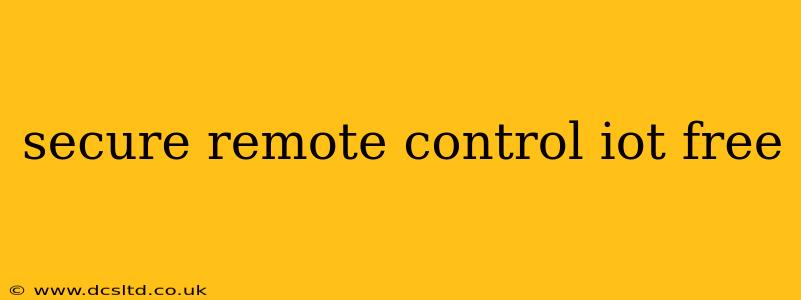Secure Remote Control of IoT Devices: A Free Guide
The Internet of Things (IoT) has revolutionized how we interact with our homes and workplaces, offering unprecedented convenience and automation. However, the ability to remotely control IoT devices also introduces significant security concerns. This guide explores how to securely control your IoT devices remotely, even without paid services, focusing on practical strategies and best practices.
Understanding the Risks
Before diving into securing your remote IoT access, it's crucial to understand the potential vulnerabilities. Unauthorized access could lead to:
- Data breaches: Sensitive information stored on your devices could be compromised.
- Device hijacking: Malicious actors could take control of your devices, potentially causing damage or disruption.
- Network infiltration: Compromised devices can serve as entry points for attacks on your entire network.
H2: What are the best free methods for secure remote access to IoT devices?
There isn't a single "best" free method, as the optimal approach depends on your specific devices and technical expertise. However, several strategies can significantly enhance security while keeping costs down:
-
Using a VPN: A Virtual Private Network (VPN) encrypts your internet traffic, making it much harder for eavesdroppers to intercept your commands or data transmitted to and from your IoT devices. While many VPNs are paid services, several free options exist, although they may have limitations on bandwidth or speed. Always research a free VPN provider carefully to ensure its security and privacy practices are reputable. A VPN protects your connection, not necessarily the devices themselves.
-
Strong and Unique Passwords: This foundational security measure remains vital. Use long, complex passwords unique to each device and account. Password managers can help you manage and generate these secure passwords effectively. Avoid default passwords provided by manufacturers.
-
Firmware Updates: Regularly update the firmware of your IoT devices. These updates often include crucial security patches that address known vulnerabilities. Check your device manufacturer's website for the latest firmware versions.
-
Firewall Protection: A robust firewall, either built into your router or installed on your network, acts as a barrier, blocking unauthorized access attempts. Configure your firewall to restrict access to only necessary ports and protocols.
-
Two-Factor Authentication (2FA): Whenever available, enable 2FA on your IoT device accounts and services. This adds an extra layer of security, requiring a second verification method (like a code sent to your phone) in addition to your password.
H2: Are there any free apps or software for remote IoT control?
Many open-source projects and free applications provide remote access functionalities, but careful vetting is essential. Before using any third-party software, investigate its reputation and security practices. Be wary of applications from untrusted sources, as they might contain malware or backdoors. A comprehensive security audit might be impossible without significant technical expertise.
H2: How can I secure my home network for my IoT devices?
Securing your home network is as vital as securing individual devices. Implement the following measures:
- Strong Router Password: Change the default password on your router to a strong, unique password.
- Enable WPA2/WPA3 Encryption: Use the most secure encryption protocols available on your router to protect your wireless network traffic.
- Regular Router Updates: Keep your router firmware up-to-date with security patches.
- Disable WPS: WPS (Wi-Fi Protected Setup) is a convenient but often insecure feature. Disable it if possible.
- Network Segmentation: If possible, create separate networks for your IoT devices, isolating them from your more sensitive devices like computers.
H2: What are the risks of using free remote access solutions for IoT devices?
Free solutions often come with limitations:
- Limited functionality: Free versions may lack advanced features found in paid services.
- Security compromises: Some free solutions may not provide the same level of security as paid alternatives, potentially exposing your devices to risks.
- Privacy concerns: Free services may collect and use your data in ways that you may not be comfortable with. Always review the privacy policy of any software or service you use.
- Support limitations: You may receive less or no technical support compared to paid services.
Conclusion:
Secure remote control of IoT devices is possible without relying on paid services. However, it requires a proactive and informed approach. By implementing these security best practices, you can significantly reduce the risk of unauthorized access and protect your data and privacy. Remember that vigilance and consistent updates are crucial for maintaining a secure IoT environment.
